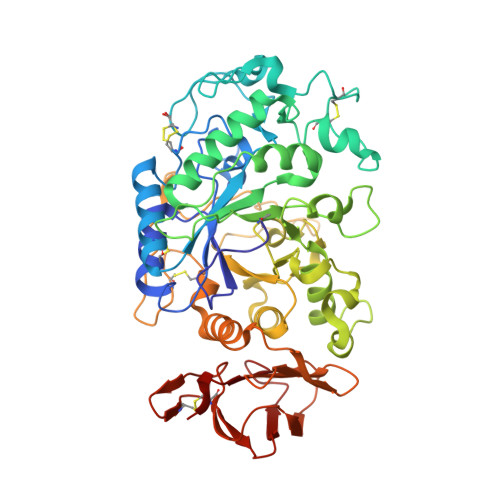X-ray crystallographic analyses of pig pancreatic alpha-amylase with limit dextrin, oligosaccharide, and alpha-cyclodextrin.
Larson, S.B., Day, J.S., McPherson, A.(2010) Biochemistry 49: 3101-3115
- PubMed: 20222716
- DOI: https://doi.org/10.1021/bi902183w
- Primary Citation of Related Structures:
3L2L, 3L2M - PubMed Abstract:
Further refinement of the model using maximum likelihood procedures and reevaluation of the native electron density map has shown that crystals of pig pancreatic alpha-amylase, whose structure we reported more than 15 years ago, in fact contain a substantial amount of carbohydrate. The carbohydrate fragments are the products of glycogen digestion carried out as an essential step of the protein's purification procedure. In particular, the substrate-binding cleft contains a limit dextrin of six glucose residues, one of which contains both alpha-(1,4) and alpha-(1,6) linkages to contiguous residues. The disaccharide in the original model, shared between two amylase molecules in the crystal lattice, but also occupying a portion of the substrate-binding cleft, is now seen to be a tetrasaccharide. There are, in addition, several other probable monosaccharide binding sites. Furthermore, we have further reviewed our X-ray diffraction analysis of alpha-amylase complexed with alpha-cyclodextrin. alpha-Amylase binds three cyclodextrin molecules. Glucose residues of two of the rings superimpose upon the limit dextrin and the tetrasaccharide. The limit dextrin superimposes in large part upon linear oligosaccharide inhibitors visualized by other investigators. By comprehensive integration of these complexes we have constructed a model for the binding of polysaccharides having the helical character known to be present in natural substrates such as starch and glycogen.
- Department of Molecular Biology and Biochemistry, The University of California, Irvine, California 92697-3900, USA.
Organizational Affiliation:





















